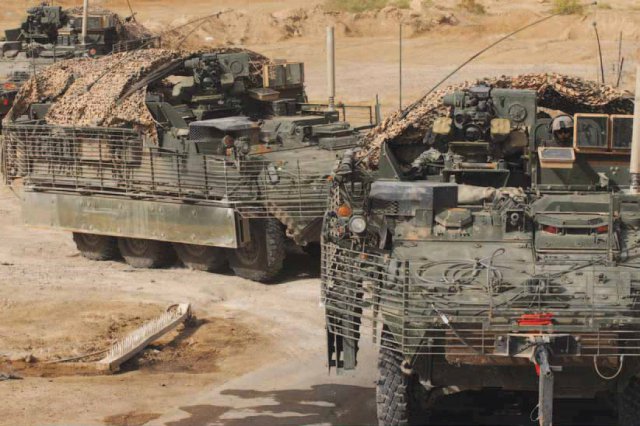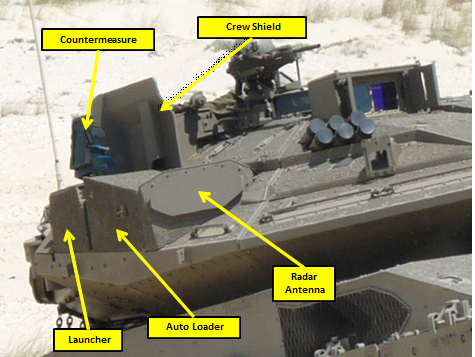
Strykers with anti-RPG slat armor in Afghanistan
WASHINGTON: A decade after the Trophy anti-missile system entered combat service on Israeli heavy tanks, manufacturer Rafael says it’s building an equally effective version at half the weight – for a customer it can’t disclose.
Rafael has previously said they’d gotten the weight of Trophy VPS down 40 percent below the original version, largely through clever design and replacing 2010-era electronics with much lighter modern versions. But now, land systems VP Michael Lurie told me, the US Army has independently streamlined the integration kit it uses to install Trophy. If you combine Rafael’s lighter VPS with the Army’s lighter integration kit, Lurie said, you cut weight in half.
That, the company says, makes the new Trophy Vehicle Protection System suitable for the 8×8 Stryker: the Army’s lightly armored 20-plus-ton vehicle that’s so far defeated attempts to install the kind of active protection systems used on 60-plus-ton Israel Merkavas, US M1s, and (most recently) German Leopard IIs. After rejecting Artis’s Iron Curtain system in earlier tests, the Army will try out Rafael’s new Trophy Vehicle Protection System and rival Rheinmetall’s ADS late this year.
For a Stryker, Lurie told me, “the whole thing together will be less than a ton.”
Getting weight down is important, especially because active protection systems have to go on top of the vehicle to get a clear view, both for the sensors – typically radar, but Trophy has added an electro-optical eye as well, and the interceptors – basically mini-missiles that shoot down incoming anti-tank missiles and rocket-propelled grenades. Smaller vehicles have less room on top and less weight to counterbalance any heavy objects installed on their roof. So what fits on a 60-plus-ton heavy tank like the M1 won’t fit on a Stryker a third as heavy.

Trophy Active Protection System components on an Israeli Merkava main battle tank.
Yet it’s lighter vehicles, with lighter armor, that most need active protection – since there are so many more kinds of anti-tank rounds that their armor cannot stop. In fact, even if an active defense system blows up an incoming warhead before it strikes the armor, there will be fragments and blast effects that might bounce off a full-size tank but still do substantial damage to a lighter vehicle.
How well does Stryker VPS handle this so-called “residual penetration”? “I can’t talk numbers on the phone,” Lurie said, “but the residual penetration is manageable with the Stryker.”
Well, what does manageable mean? Will the crew survive but the vehicle be totaled? Or will the Stryker be able to shrug off whatever shrapnel gets past Trophy and continue with its mission?
“It can protect a Stryker crew to a very, very high level,” Lurie told me. “The system protects the entire vehicle… front to end,” he said, so it should remain intact and drivable. (I didn’t ask specifically whether unarmored external components like sensors and radio antenna would survive intact, but those are notoriously vulnerable).
Overall, he said, because the sensor quality, software, and interceptors are the same, Stryker would get “the same … active protection” as a tank.
What makes Lurie especially confident is that this Trophy VPS system is no longer a lab experiment or developmental product: It’s currently being built on a production assembly line. However, the client has asked Rafael not to disclose who they are or any other details. (My guess is it’s the Israeli Defense Force itself in a typically hypercautious mode, or perhaps a key Arab ally, but that’s pure speculation on my part).
Lurie says Rafael will continue to work on reducing Trophy’s weight, but he doesn’t expect any more major decreases. Instead it’s focusing more on upgrading Trophy’s capabilities – including making it compatible with the US Army’s forthcoming Modular Active Protection System. The Army wants MAPS to plug-and-play components from different vendors – a radar from this one, an interceptor from that one, a jammer from the other – so it can upgrade rapidly without being tied to any one contractor such as Rafael.
“MAPS is a good approach, the right approach,” Lurie said. Once the US finalizes the MAPS architecture, he expects to be able to make Trophy compatible with a modest investment in “several months.”
Australia tops up Ukraine military aid with $100M
Australia has already supplied Ukraine with 120 Bushmaster vehicles, six 155mm howitzers, 56 M113 armored vehicles, 14 special operations vehicles and its signature cardboard drones.


























